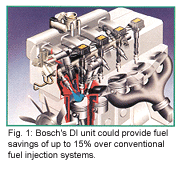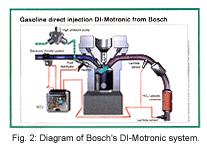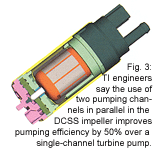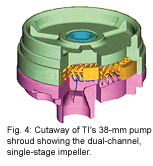ls, appear to be the next generation of fuel injection for gasoline engines. The reasons for implementing this technology are legislative, and also include market requirements that drive the need to reduce fuel consumption, while at the same time, meet the increasingly stringent exhaust emissions regulations. According to engineers at Delphi Corp., gasoline direct injection can improve combustion efficiency and reduce pumping losses, both of which result in improved fuel economy.
The first-generation of this technology has been around since the early 1990s, and uses a wall-guided technology with side-mounted injectors to spray the gasoline directly into the cylinder at a pressure of up to 120 bar.
The in-cylinder charge motion (either swirl or tumble) helps to raise the charge up to the spark plug for ignition. Research by automotive engineers has determined that the side-mounted injector position presents the most feasible method for the vehicle manufacturers to utilize a direct injection system, since they would not have to redesign the cylinder head. Also, it’s easier to cool the injector and spark plug using the side-mounted concept. However, with this design, fuel economy savings are only about 7%.
Delphi researchers said that to achieve the maximum fuel economy benefits (as high as 20%), the injector should be mounted in the center of the combustion chamber (central injection) to apply a spray-guided process. Here, the fuel spray is targeted directly to the spark plug, and does not rely on the in-cylinder charge motion to put the fuel at the spark plug.
But the significant challenges for central injection include packaging a spark plug and injector in a crowded valve-bridge area, especially with a four-cylinder head. Attention also must be paid to cylinder head wall thickness and the possibilities of higher temperatures, which could lead to injector deposit issues.
As reported in a previous issue of Underhood Service (“IC Engine Still Sparking the Industry,” August 2000), Delphi and Orbital Engine Corp. began work on a second-generation spray-guided direct injection system. That partnership has lead to the development of a system that uses a standard multi-port fuel injection (MPFI) injector combined with an air injector. An air/fuel mixture is directly injected into the combustion chamber at 6.5 bar air pressure.
A presentation of the Delphi/Orbital air-assisted, spray-guided direct injection combustion system was given at the SAE 2002 World Congress in Detroit. To review that technical paper and others on Orbital’s direct injection research, visit www.orbeng.com/orbital/orbitalTechnology/tech/tech_4stroke_auto.htm.
Recent Developments
Engineers for Robert Bosch announced recently that they have developed a gasoline DI unit that provides up to 15% fuel savings, increased torque, quick response and less complexity. Utilizing high-pressure injection of fuel directly into the combustion chamber, the Bosch system for gasoline engines combines direct injection and turbo-charging benefits, according to Al Krenz, director of service for Bosch.
As Bosch envisions it, in the not-so-distant future the Bosch “DI Motronic” gasoline direct injection system will create a “dual driving pleasure,” providing greater torque and speed yet yielding improved fuel economy.
“In comparison to port fuel injection, the torque curve of direct injection turbocharged engines is improved throughout the whole speed range. Direct injection (see Figures 1 and 2) has a special effect on the  start-up torque, and maximum torque is also available at low speed. This produces a very regular, smooth power output throughout the engine’s normal rpm range,” Krenz said.
start-up torque, and maximum torque is also available at low speed. This produces a very regular, smooth power output throughout the engine’s normal rpm range,” Krenz said.
The interaction between direct injection and turbocharging also is a basis for “further downsizing,” which promises even greater fuel economy. Downsizing in this context means that conventional naturally aspirated engines are replaced by more compact and more powerful turbocharged engines. “If the piston displacement is reduced by one-third, fuel consumption with direct injection can be lowered by 15%,” said Krenz.

The side-mounted Bosch concept provides engineers with greater freedom for increasing the efficiency of supercharged gasoline engines. To achieve this, engineers can make use of a specific advantage of direct injection – the intake valves, which pump exclusively fresh air into the cylinder and not a combustion mix, as is the case in port fuel injection. Fuel is injected directly into the combustion chamber, immediately before ignition, at which point the valves are already shut again. In the new Bosch concept, intake and exhaust valves stay open longer during the intake phase, and a greater volume of fresh air enters the cylinder.
How DI Is Different
Conventional engines today use a fuel injection system, which replaced the carburetors of yesteryear. Multi-Point Injection (MPI), where the fuel is injected to each intake port, is the most widely used fuel delivery system today. However, with MPI engines, there are limits to fuel supply response and the combustion control because the fuel mixes with air before entering the cylinder.
So, unlike the conventional MPI system, direct injection prevents unburned fuel from getting into the exhaust, which might increase fuel consumption as well as exhaust emissions. With a lower counter pressure, more air rushes into the combustion chamber to form the combustion mix – resulting in a more powerful combustion.
Bosch engineers said they also are working on optimizing combustion timing. The moment of ignition is defined by the “knock limit” – the point of unintended self-ignition. The Bosch DI Motronic system cools the combustion air with the fuel directly injected into the cylinder, which reduces the knocking tendency. Thus, the regular combustion of the mix following ignition through the spark plug can happen at a later point in time with a greater energy conversion.
Currently, Bosch continues to develop direct injection for more efficient combustion processes. DI Motronic, using spray-guided combustion, also lowers fuel consumption by up to 15% in engines without turbocharging, Krenz noted. Rapid-switching, high-pressure injectors with piezo actuators, specifically tuned to the new combustion process, will be ready for large-volume production by next year. In parallel, Bosch develops low-cost, compact solenoid-controlled high-pressure injectors with multi-aperture nozzles, which are universally applicable for all combustion processes with gasoline direct injection.
The Importance of the Pump in DI Systems
Another company that is ready for the takeoff in gasoline direct injection technology is TI Automotive, which announced in May that it has introduced a dual-channel, single-stage (DCSS) line of fuel pumps that the company predicts will “set a new industry standard for efficiency.”
Developed by a TI Automotive research and development team in Michigan, the turbine pump is a “cost-efficient fuel pump designed to meet the high fuel pressure requirements of gasoline direct injection engines.” According to David Ford, TI Automotive’s director of advanced fuel delivery and application engineering, the DCSS pump (see Figures 3 and 4) will enable automakers to increase fuel efficiency, reduce emissions and improve the overall performance of future gasoline engines. “Within the next six years, we expect this new design to replace a majority of the fuel pumps that we produce on a global basis.”

In addition to more conventional applications, the new pump is suited for use with saddle-style fuel tanks found on many high-performance vehicles.
Ford said the DCSS pump, which will debut on selected 2006-model vehicles, is engineered to provide automakers with improved efficiency, higher fuel pressures and increased pump life, adding the pump offers the most significant gain in pump efficiency in years. “It operates at efficiency levels of up to 30%, nearly 50% higher than the typical 20% efficiency of today’s turbine pumps.”

Ford said the DCSS pump incorporates two rows of turbine blades that feed two parallel high-pressure pumping channels, compared to a conventional single-stage pump that uses an impeller with a single row of blades at its outer edge. “The end result effectively doubles the flow of fuel through the pump,” he said.
For high-flow/high-pressure requirements, the DCSS 39/50 pump uses a 50 mm pump housing coupled with a proven 39 mm motor used for the company’s present, single-stage T-8 family of pumps. TI Automotive’s designers concentrated on creating a larger, 50 mm inlet housing and a larger impeller to make room for a unique second row of turbine blades. The patent-pending, dual high-pressure design maintains velocity in the fuel channel by splitting the inner and outer flow paths.
Ford explained the unique pumping sections were designed in parallel, not in series as in other two-stage pump designs, and the impeller was engineered with unique curved-leaning blades, both of which help to reduce fuel turbulence and increase pump output. “Present single-stage turbines only give you a maximum pressure of about 5 bar and flow rates of 180 liters per hour,” Ford said. “That’s far short of the fluid pressures and volume needed for advanced direct injection engines.”
The DCSS 39/50 produces flow rates of 200 to 240 liters per hour at pressures ranging from 4 to 6 bar and easily meets DI performance criteria. Ford also pointed out that present single-stage pumps only operate at about 20% efficiency. “We’ve consistently scored 30% efficiency at 240 liters per hour at 4 bar, and at higher 6 bar pressures, we can achieve greater than 26% efficiency at 200 liters per hour.”
One of the biggest hurdles in designing gasoline direct injection systems is the issue of intense heat. “Not only do we need to deliver a cooler fuel, but engine-mounted, direct injection pumps hold high tolerances, and if they are exposed to high temperatures, the varying coefficients of thermal expansion in the pump material can create lockup,” Ford said.
In “hot fuel” tests, the DCSS 39/50 scored high. Although single-stage turbine pumps show flow losses ranging from 12% to 32% at operating temperatures up to 67° C (153° F), Ford said the DCSS 39/50 showed only an 8% drop in flow under identical test conditions.
Tech Effect
How direct injection will affect service technicians remains to be seen. One issue could be tighter engine compartments, making service to the fuel injection components even tougher.
Also, during the infancy of this technology, technicians may need to service the fuel system (injectors and exhaust ports) more often than on conventional fuel-injected vehicles in order to remove deposits and carbon buildup as a result of high engine temperatures.
But, understanding how DI systems work on gasoline engines could help your technicians better diagnose DI problems and service fuel injection systems on diesel engines, which may be unfamiliar territory. In essence, this could help shops take on additional diesel service and repair that normally they may steer away.
|
